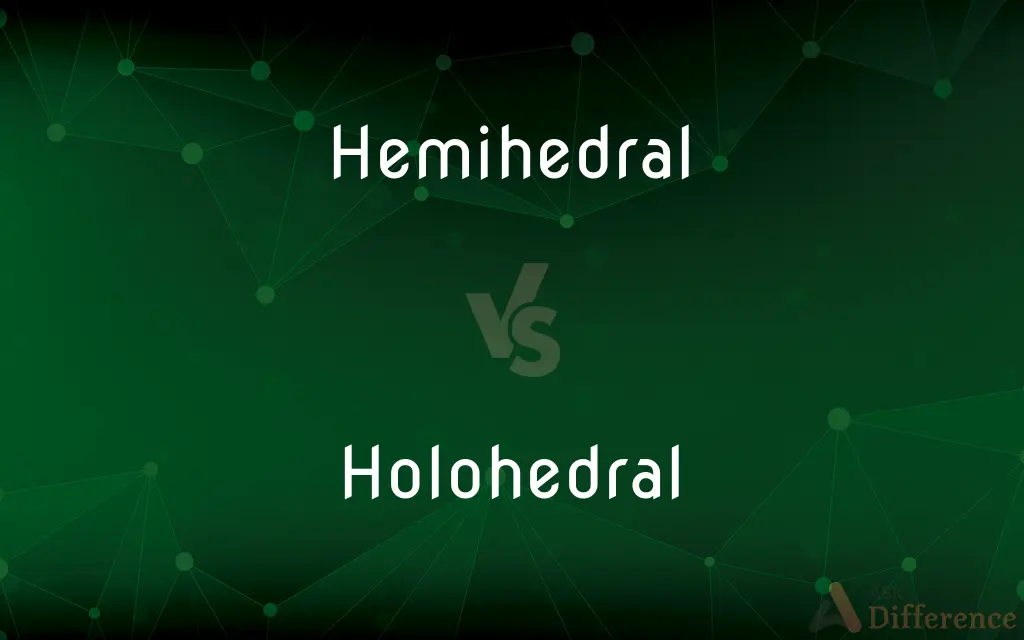Hemihedral vs. Holohedral — What's the Difference?
By Tayyaba Rehman & Maham Liaqat — Updated on May 7, 2024
Hemihedral crystals exhibit only half the faces required by full symmetry, while holohedral crystals possess all faces necessary for complete symmetry.

Difference Between Hemihedral and Holohedral
Table of Contents
ADVERTISEMENT
Key Differences
Hemihedral crystals have a limited number of symmetrical faces compared to their symmetrical counterparts. They show only half the faces theoretically possible for their crystal system. Holohedral crystals, on the other hand, display all faces predicted by the full symmetry of their crystal class.
Hemihedral crystals form when symmetry is restricted, often due to specific conditions during the crystallization process. Holohedral crystals form under ideal conditions, adhering to the complete geometric symmetry inherent in their structure.
In hemihedral crystals, the reduced number of faces leads to unique shapes that reflect partial symmetry. Holohedral crystals have consistent and regular shapes that faithfully represent the full symmetry of the crystal system.
Hemihedral crystals often occur in minerals where specific factors interrupt complete growth patterns. Holohedral crystals are typical in conditions that allow full symmetry to develop, resulting in well-formed geometric shapes.
Comparison Chart
Symmetry
Half of the required symmetry faces
All faces required for full symmetry|
ADVERTISEMENT
Formation
Limited by specific growth conditions
Forms under ideal growth conditions|
Shape
Unique shapes reflecting partial symmetry
Consistent shapes reflecting complete symmetry|
Prevalence
Occurs due to interrupted growth
Occurs with uninterrupted, complete growth|
Crystal System
Partially symmetrical
Fully symmetrical |
Compare with Definitions
Hemihedral
Refers to reduced crystal faces compared to fully symmetrical crystals.
The rock was identified as hemihedral based on its fewer visible crystal faces.
Holohedral
Refers to crystal growth with full geometric symmetry.
The crystal's holohedral shape indicates it developed under ideal conditions.
Hemihedral
Characterized by incomplete geometric forms.
The hemihedral forms contrasted sharply with the perfect geometric shapes nearby.
Holohedral
Showing all the faces characteristic of its crystal system.
The mineral displayed a holohedral crystal habit with well-formed faces.
Hemihedral
Exhibiting only half the faces required by the full crystal symmetry.
The mineral showed hemihedral crystal forms due to restricted growth conditions.
Holohedral
Pertaining to structures fully consistent with their crystal symmetry.
The holohedral crystals were measured to confirm their geometric proportions.
Hemihedral
Pertaining to crystal growth with partial symmetry.
The hemihedral crystals were studied to understand their symmetry limitations.
Holohedral
Characterized by full symmetry in crystal faces.
The mineralogist classified the sample as holohedral based on its consistent symmetry.
Hemihedral
Describing crystals with diminished symmetry faces.
The hemihedral formations indicate conditions that interrupted full growth.
Holohedral
Describing crystals that completely exhibit their geometric properties.
The holohedral crystals were perfect examples of their mineral group.
Hemihedral
Exhibiting only half the faces required for complete symmetry. Used of a crystal.
Holohedral
Having as many planes as required for complete symmetry in a given crystal system.
Hemihedral
(of a crystal) Having only half the plane faces needed for the highest degree of symmetry in its system
Holohedral
(of a crystal) Having as many plane faces as needed for the highest degree of symmetry in its system
Hemihedral
Having half of the similar parts of a crystals, instead of all; consisting of half the planes which full symmetry would require, as when a cube has planes only on half of its eight solid angles, or one plane out of a pair on each of its edges; or as in the case of a tetrahedron, which is hemihedral to an octahedron, it being contained under four of the planes of an octahedron.
Holohedral
Having all the planes required by complete symmetry, - in opposition to hemihedral.
Common Curiosities
What is the main difference between hemihedral and holohedral?
Hemihedral crystals have only half the required faces, while holohedral crystals have all faces for full symmetry.
Why are some crystals hemihedral?
Hemihedral crystals form due to restricted growth conditions that prevent full symmetry from developing.
What role do external factors play in forming hemihedral crystals?
External factors such as temperature and pressure can affect crystal growth, resulting in hemihedral shapes.
How does the growth environment affect hemihedral and holohedral forms?
A growth environment that allows unrestricted growth promotes holohedral forms, while restrictions lead to hemihedral shapes.
Are holohedral crystals more valuable than hemihedral ones?
Not necessarily; value depends on the rarity and quality of the crystal rather than symmetry alone.
Do all crystals form holohedral shapes?
No, holohedral crystals form under ideal growth conditions that allow the full geometric symmetry of the system.
Is holohedral symmetry ideal for all crystals?
Holohedral symmetry is ideal but not always possible due to environmental factors that affect crystallization.
Are hemihedral shapes less common than holohedral shapes?
Yes, hemihedral shapes are less common as they form under specific conditions that interrupt regular growth.
Can hemihedral and holohedral forms coexist in the same sample?
Yes, different parts of a sample may exhibit both forms if growth conditions varied over time.
How does crystal symmetry relate to hemihedral and holohedral forms?
Symmetry defines the crystal faces; hemihedral forms have fewer faces, and holohedral forms exhibit complete faces.
Can the same mineral exhibit both hemihedral and holohedral forms?
Yes, the same mineral can show both forms based on varying growth conditions.
Do hemihedral crystals retain geometric symmetry?
Yes, they retain partial symmetry even though they don't have the full complement of faces.
Do hemihedral crystals have practical applications?
Yes, some industries exploit their unique shapes and properties for specific applications.
Do hemihedral forms represent a particular crystal system?
They can occur in any crystal system, provided specific conditions cause limited growth.
Is it possible to predict whether a crystal will be hemihedral or holohedral?
Prediction depends on understanding the growth environment and specific mineral properties.
Share Your Discovery

Previous Comparison
Kumquat vs. Orange
Next Comparison
Doze vs. SleepAuthor Spotlight
Written by
Tayyaba RehmanTayyaba Rehman is a distinguished writer, currently serving as a primary contributor to askdifference.com. As a researcher in semantics and etymology, Tayyaba's passion for the complexity of languages and their distinctions has found a perfect home on the platform. Tayyaba delves into the intricacies of language, distinguishing between commonly confused words and phrases, thereby providing clarity for readers worldwide.
Co-written by
Maham Liaqat















































